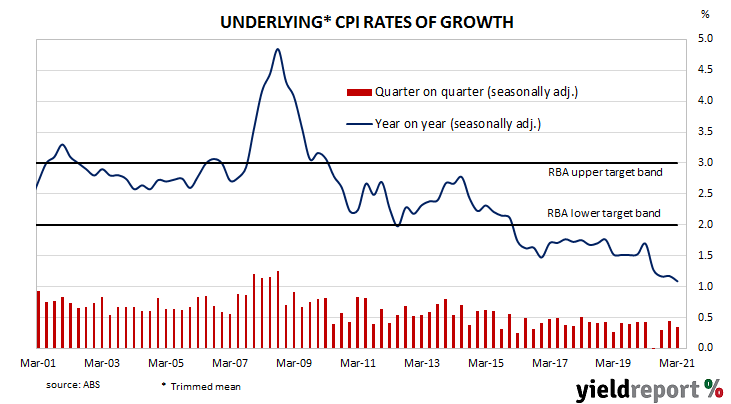Summary: Inflation rate less than market expectations in March quarter; RBA preferred measure also less than expected; transport, health main drivers of result.
In the early 1990s, entrenched inflation in Australia was broken by the “recession we had to have” as it became known. Since then, underlying consumer price inflation has averaged around 2.4%, a little below the midpoint of the RBA’s target range of 2%-3%. Following the GFC, various measures of consumer inflation have been in a down-trend despite attempts by the RBA to increase them through historically low cash rates.
Consumer price indices for the March quarter have now been released by the ABS and both the headline and seasonally-adjusted figures were lower than the 0.9% which had been generally expected. The headline inflation rate came in at 0.6% for the quarter, less than the December quarter’s 0.9%. The seasonally-adjusted inflation rate also slowed in comparison to the previous quarter, from a revised rate of 0.9% to 0.5%. On a 12-month basis, the headline rate registered 1.1%, while the seasonally-adjusted rate posted a 1.0% increase. In the December quarter, their respective rates were both 0.9%.
The RBA’s preferred measure of underlying inflation, the “trimmed mean”, was also less than expected. The trimmed mean inflation rate for the March quarter was +0.3%, less than the market’s expected figure of 0.5% and slightly lower than the December quarter’s 0.4%. The 12-month growth rate slipped from 1.2% to 1.1%.
 Commonwealth Government bond yields moved a little lower on the day. By the close of business, the 3-year ACGB yield had lost 2bps to 0.27% and the 10-year yield had slipped 1bp to 1.69%. The 20-year yield remained unchanged at 2.40%.
Commonwealth Government bond yields moved a little lower on the day. By the close of business, the 3-year ACGB yield had lost 2bps to 0.27% and the 10-year yield had slipped 1bp to 1.69%. The 20-year yield remained unchanged at 2.40%.
In the cash futures market, expectations of a change in the actual cash rate, currently at 0.03%, remained largely unchanged. At the end of the day, contract prices implied the cash rate would inch up slowly to around 0.12% by September 2022.
The main driver of the headline inflation figure in the quarter was a 3.2% rise in transport prices, contributing 0.3% points of the 0.6% (unadjusted) increase over the quarter. The health segment had the next largest influence on the quarter; it increased by 2.0% and contributed just over 0.1% points to the quarterly total.

